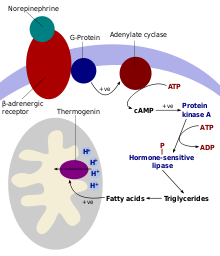- Thermogenesis
-
Not to be confused with thermogeneration.
Thermogenesis is the process of heat production in organisms. It occurs mostly in warm-blooded animals, but a few species of thermogenic plants exist.
Contents
Types
Depending on whether they are initiated through locomotion and intentional movement of the muscles, thermogenic methods can be classified as one of the following:
- Exercise-associated thermogenesis (EAT)
- Non-exercise activity thermogenesis (NEAT)
- Diet-induced thermogenesis (DIT)
Shivering
One method to raise temperature is through shivering. It produces heat because the conversion of the chemical energy of ATP into kinetic energy causing some of the energy to show up as heat. It is not 100% efficient. No real movement is produced in shivering because opposing (antagonistic) muscle pairs are activated at the same time resulting in the shivering.
Non-shivering thermogenesis
Non-shivering thermogenesis usually occurs in brown adipose tissue (brown fat) that is present in human infants, and hibernating mammals. Non-shivering thermogenesis can be obligatory or facultative. Obligatory thermogenesis is the heat production automatically caused by the metabolic rate, while facultative thermogenesis can be activated in cold exposure to raise body temperature.
In this process, substances such as free fatty acids (derived from triacylglycerols) remove purine (ADP, GDP and others) inhibition of thermogenin (uncoupling protein-1), which causes an influx of H+ into the matrix of the mitochondria and bypasses the ATP synthase channel. This uncouples oxidative phosphorylation, and the energy from the proton motive force is dissipated as heat rather than producing ATP from ADP, which would store chemical energy for the body's use. Thermogenesis can also be produced by leakage of the sodium-potassium pump and the Ca2+ pump. Thermogenesis is contributed to by futile cycles, such as the simultaneous occurrence of lipogenesis and lipolysis or glycolysis and gluconeogenesis.
The low demands of thermogenesis mean that free fatty acids draw, for the most part, on lipolysis as the method of energy production.
Regulation
Non-shivering thermogenesis is regulated mainly by thyroid hormone and the sympathetic nervous system. Some hormones, such as norepinephrine and leptin, may stimulate thermogenesis by activating the sympathetic nervous system. Rising insulin levels after eating may be responsible for diet-induced thermogenesis (thermic effect of food).
Potential use in obesity
As a significant component of the metabolic rate, thermogenesis can potentially be stimulated to increase energy expenditure and fat oxidation. Thermogenics are commonly made up of ephedra, bitter orange, capsicum, ginger, guar gum, and pyruvate. Caffeine and EGCG, both found in green tea, may increase thermogenesis regulated by catecholamines such as norepinephrine. Researchers are also investigating the possibility of increasing the amount of brown adipose tissue in the body, a site of thermogenesis. Leptin infusions, being studied due to the leptin resistance seen in obesity, may boost metabolism by stimulating thermogenesis and also reduce hunger and appetite.
Although bodybuilding formulations comprise the most common use of thermogenics, the drugs are entering the mainstream dieting industry.
See also
External links
Categories:
Wikimedia Foundation. 2010.

